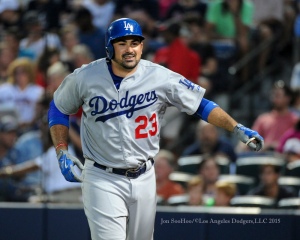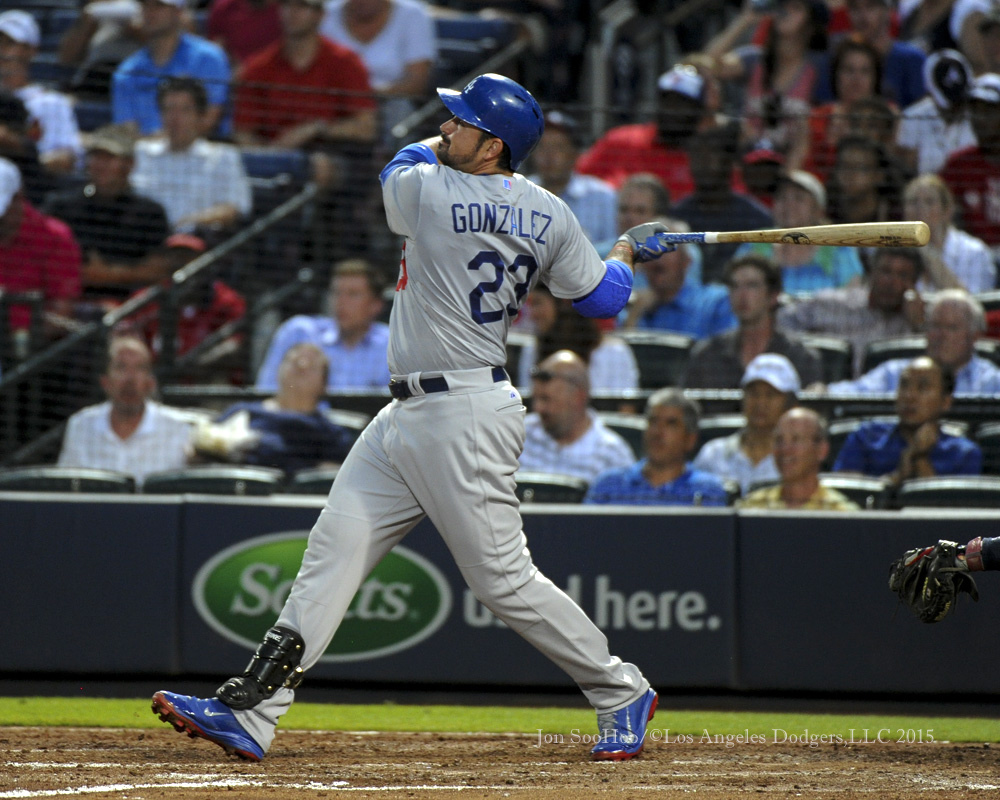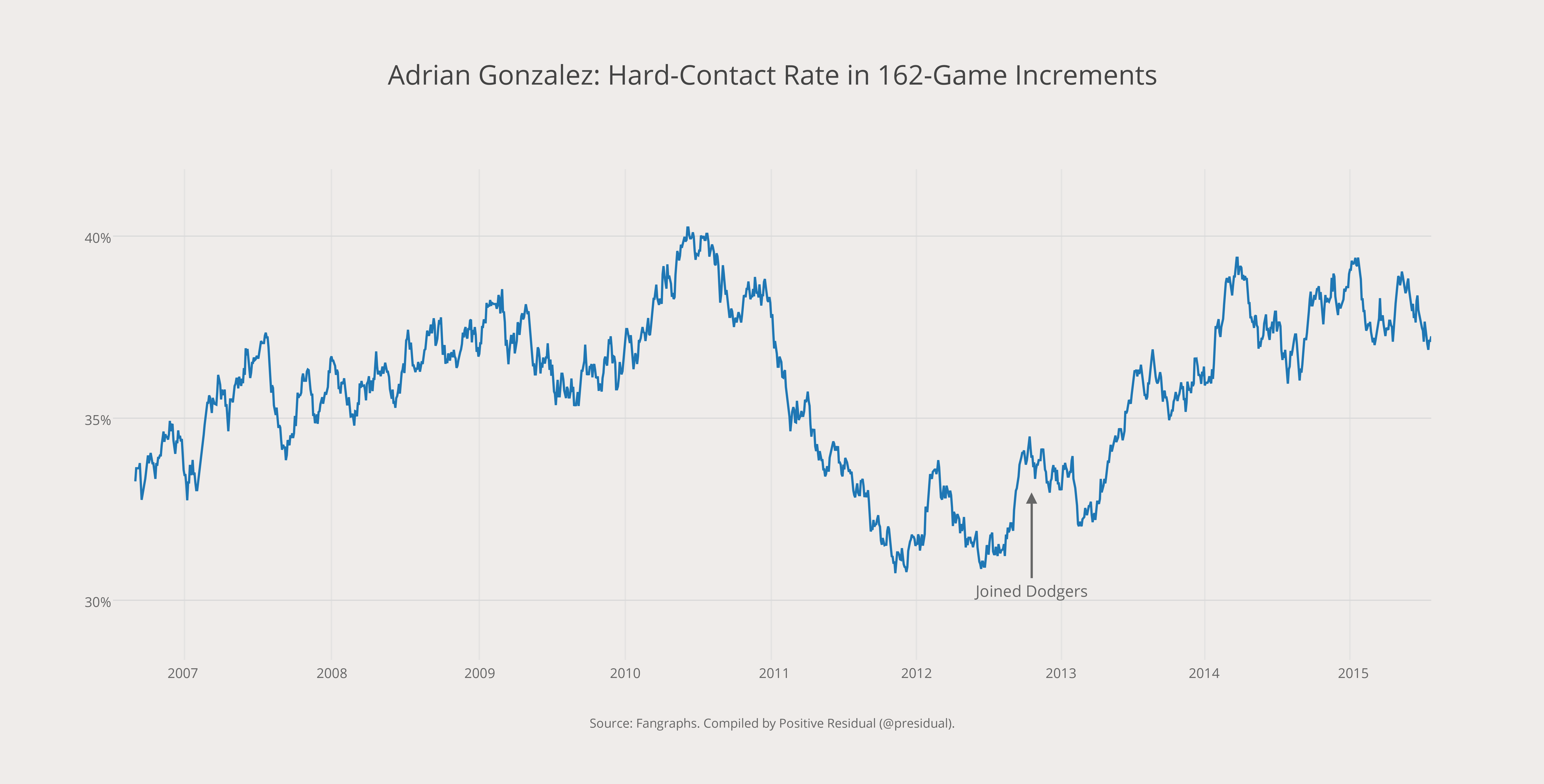By Robert Tagorda
When Adrian Gonzalez made the All-Star team earlier this month, it capped a prodigious first half in which he batted .283/.355/.520 with 18 home runs. But it also recognized a longer trend of elite production — one that reflected a return of his power.
Over the past calendar year, Gonzalez has amassed a .395 weighted on-base average, following the likes of Mike Trout, Buster Posey and Jose Bautista in the Major League top eight. He has created 58 percent more runs than the average hitter. If we adjust for park and league factors, we can say that he’s been the fifth-most productive batter over his last 640 plate appearances.
Throughout this timeframe, Gonzalez has done well in many aspects of the hitting game, but his power numbers have really stood out. While his .369 on-base percentage has ranked 19th among qualified hitters, his 34 home runs have placed him in the top 10, and his .559 slugging percentage has cracked the top five. In the National League, only Giancarlo Stanton, Nolan Arenado, and Bryce Harper have exceeded his .255 isolated power.
So it’s evident that, since last year’s Midsummer Classic, Gonzalez has slugged with the best of them. But is it just a temporary surge? Or does it represent a more enduring reemergence of his power?
 To answer these questions, we can draw inspiration from the stock market and analyze the simple moving average of Gonzalez’s key slugging statistics. By taking his entire career and breaking it down into 162-game increments, we can get a better sense of long-term trends in his performance. As we even out his brief slumps and streaks through the years, we can get a clearer view of the big picture.
To answer these questions, we can draw inspiration from the stock market and analyze the simple moving average of Gonzalez’s key slugging statistics. By taking his entire career and breaking it down into 162-game increments, we can get a better sense of long-term trends in his performance. As we even out his brief slumps and streaks through the years, we can get a clearer view of the big picture.
Overall, this analysis suggests that, since joining the Dodgers in August 2012 at the low point of his slugging prowess, Gonzalez has gradually regained his form. He’s now right around his career averages, and he has been maintaining this performance for a prolonged period.
Let’s start with how hard he has hit the ball. At his peak in 2010, Gonzalez made contact with authority about 40 percent of the time — an excellent rate. At his nadir in 2012, he dropped to the low 30-percent range. Since his trade from the Boston Red Sox, he has climbed back up to 38 percent. Despite some struggles along the way, he has remained at or slightly above his career average of 36 percent through the past three All-Star games.
Data up to date through Tuesday. Click any chart to enlarge.
A similar story unfolds when we focus on the trajectory of Gonzalez’s batted balls. Typically, power is associated with high fly-ball rates, while large volumes of hits come with high line-drive rates. Before 2011, Gonzalez routinely hit fly balls around 40 percent of the time and line drives around 25 percent of the time. After this gap narrowed to within eight points in 2012, it began to move back toward career levels over a three-year period. So, as he has made harder contact again, balls have concurrently soared.
Furthermore, as Gonzalez’s fly balls have increased, more of them have also left the yard. Just a month prior to becoming a Dodger, only 10 percent of his fly balls were home runs — a rather pedestrian rate. Now, he’s back around 15 percent, which is where home run hitters tend to be.
It’s no wonder that, if we consider 600 plate appearances for a standard season, Gonzalez’s home run pace has gradually risen from as low as 14 during the 2012 All-Star game to nearly 30 today.
Of course, power is not merely about home runs. If we look more broadly at ISO, we see the same general trend. Over the past three years, Gonzalez has gone up from roughly .150 to just below .250, a rule-of-thumb benchmark for slugging excellence.
While we can safely say that this recent production is no fluke, and sample sizes over 550 plate appearances usually start becoming reliable predictors of future performance, it’s still no guarantee that Gonzalez will retain his power output in the coming years. For one thing, he’s 33 years old. Age takes an unkind toll on ISO, and it can counteract his resurgence at any moment. Gonzalez’s 2010 shoulder surgery is also a critical factor, as are related changes to his hitting approach. But it’s reasonable to expect that he’ll stay close to his career averages in the near term, which should help lead the Dodgers during their playoff hunt.
Robert Tagorda writes about baseball and basketball from Los Angeles. Follow him at @presidual.










oldbrooklynfan
If anyone fits the term “MVP” for the Dodgers AGon certainly does.